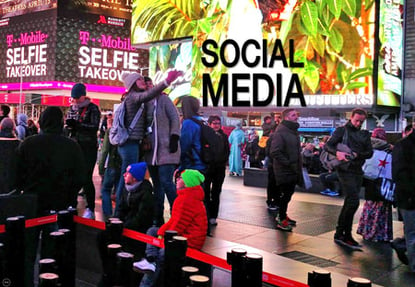 I was in Lawrence, KS yesterday for the latest SocialIRL program created by Ben Smith and featuring HARO-creator, Peter Shankman. The day's underlying theme was customer service in the age of social media. That’s actually a bit of a misnomer though, because so many of the principles Peter Shankman shared are solid customer service and communication strategies even if social media weren't around.
I was in Lawrence, KS yesterday for the latest SocialIRL program created by Ben Smith and featuring HARO-creator, Peter Shankman. The day's underlying theme was customer service in the age of social media. That’s actually a bit of a misnomer though, because so many of the principles Peter Shankman shared are solid customer service and communication strategies even if social media weren't around.
As opposed to a lot of presentations you see, Tuesday's Peter Shankman SocialIRL session was more about storytelling, entertainment, engagement, videos, and technical glitches. You probably couldn't have a better translation of what happens in social media to an in real life setting. From that standpoint then, the day definitely fulfilled the event theme!
As a recap, here are 11 take-aways from SocialIRL:
STRATEGY
1. “Embrace the concept, not the brand.” - Peter Shankman
Absolutely. Brands (in this case, social media platforms) may come and go, but underlying concepts (i.e., mobile marketing) have more staying power and can be the strategic foundations for marketing plans.
2. “Social media is all about quicker, faster, and better. People do the quicker & faster, but forget about the better.” – Peter Shankman
If you’re not getting attention for your content, then you have to look at what you’re creating and how to make it more relevant and meaningful to your audiences.
3. “If you don’t listen to your customers, someone else will.”
Even if you can’t sell-in a social media program in your organization, you have to start listening to understand what customers, prospects, and others active in your industry are saying about you. Social media listening is both the source of opportunities and the way to head off more serious problems.
4. "Let us not underestimate the power cool has. Any time you can make your customers feel cool, they will do your PR for you.” – Peter Shankman
Give your audience things that make them seem cool and cooler than the audience they’re sharing your content with online.
CUSTOMER SERVICE
5. Good customer service kills online problems before they become problems online.
Finding links between brands with strong customer service and successful social media efforts (i.e. Southwest Airlines) isn’t a coincidence. A cultural orientation toward understanding customers and going out of your way to meaningfully engage with them translates from offline into the online world much easier than trying to create a new attitude in social media.
6. There are 3 critical steps in addressing customer issues online.
Relative to customer issues, the three key steps are to listen, analyze, and personalize your reply. The analyze step is especially important. While there’s a need for a timely reply (Shankman claims 1 to 3 hours response time on Twitter is adequate), your person responding should understand the service recovery options available and know what steps they’ll be using to address the customer issue.
7. If legal concerns are an issue for social media in your organization, use the 80-20 rule to be able to interact more effectively online.
When it comes to having a two-way conversation, many organizations, especially regulated ones, can look at what customer service issues come up most frequently and craft 5 or 6 messages which answer a majority of questions and point people in the right directions.
SOCIAL MEDIA MISTAKES BRANDS MAKE
8. In answer to a question about what he sees brands doing wrong in social media, Peter Shankman offered these:
- Not acting quickly enough – This is a result of fears from legal implications or other potential issues, or the need to get more people involved. By the time everything is ready to go, opportunities are lost.
- Afraid to offend anyone – Lots of humor isn't being used because brands are afraid of it. When a brand uses humor, the humor needs to tie to the brand and its audiences. As Shankman puts it, “Funny stuff equates to viral.”
- Not learning from mistakes – He suggests Googling the top social media mistakes and learning from what mistakes others have made in social media.
- Not listening enough (or well enough) – Peter Shankman recommends more listening and less talking. And when listening, brands need to do a better job of responding.
COMMUNICATION SKILLS
9. The killer social media skill is writing.
Peter Shankman’s stat was that we have 2.7 seconds (or essentially 3 sentences) to reach our audiences. Doing that successfully depends on knowing how to write, and knowing especially how to write headlines. He encourages his employees to take as many writing classes as they want to continually improve.
10. When you have a speaking element that works, repeat it often.
One of Peter Shankman’s most effective speaking approaches is drawing comparisons to yesterday’s world by linking it to things people under 30 are familiar with. Examples: “The radio is like Pandora before the Internet” and “Madonna is like Lady Gaga with more kids.” Not only are these similes effective for all age ranges, the familiarity of hearing them throughout his talk added both impact and anticipation.
AN OBSERVATION
11. Peter Shankman may be the Forrest Gump of web 2.0.
The day opened with stories form Peter Shankman about his move from being 18 hours short of a degree in California to being at the center of a variety of online blow–ups, including HARO. He didn't really offer any rules or strategic lessons learned for accomplishing this, other than to create strong content, have a brilliant idea, and plan for outrageous success. Absent any easy lessons, it seems to be either a numbers game (create enough content and hope for brilliance), dumb luck (Lance Armstrong RTs an xtranormal video you did), or some apparent combination of the two. – Mike Brown
The Brainzooming Group helps make smart organizations more successful by rapidly expanding their strategic options and creating innovative plans they can efficiently implement. Email us atbrainzooming@gmail.com or call 816-509-5320 to learn how we’ve developed integrated social media strategy for other brands and can do the same for yours.

